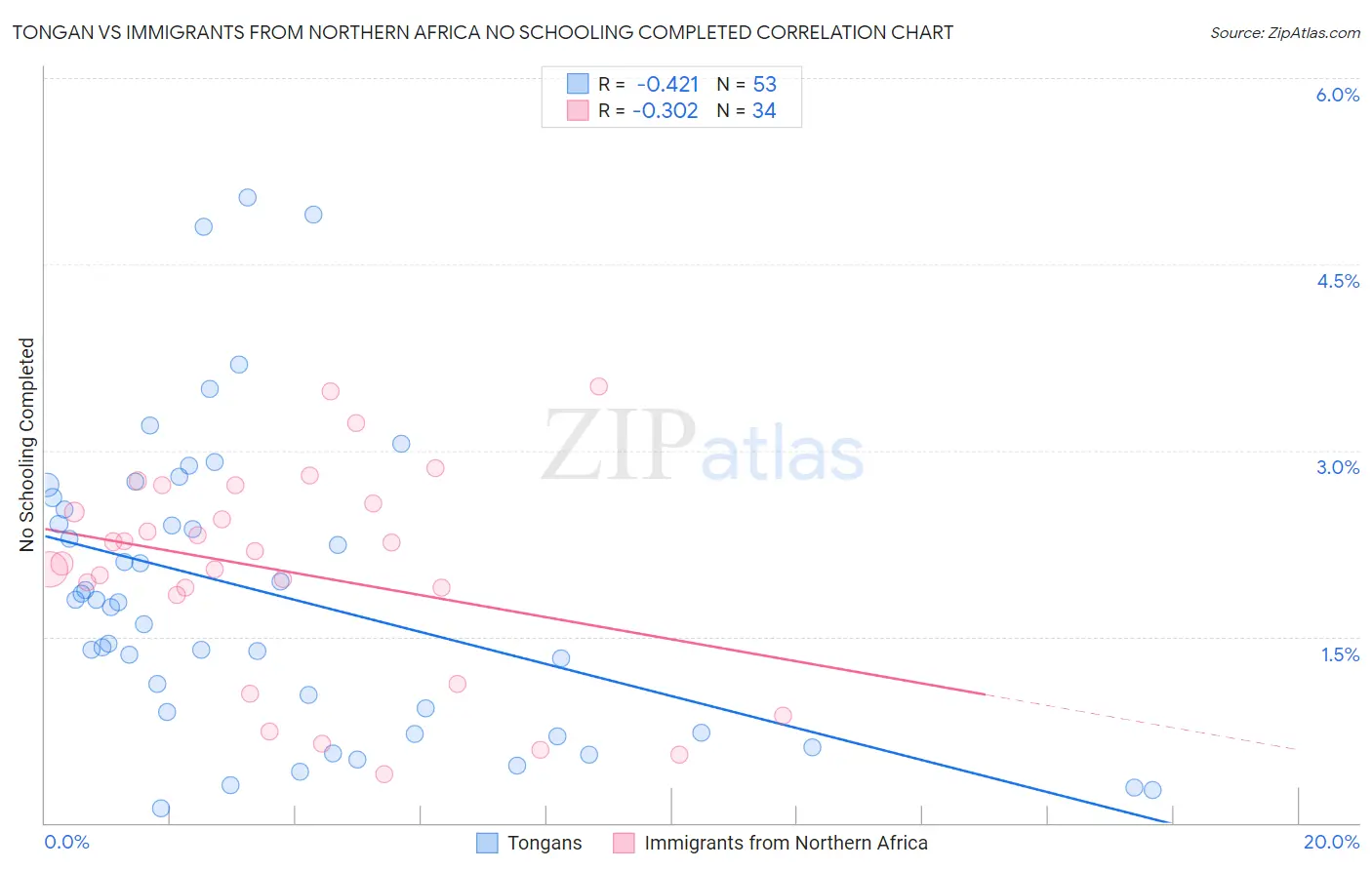Tongan vs Immigrants from Northern Africa No Schooling Completed
COMPARE
Tongan
Immigrants from Northern Africa
No Schooling Completed
No Schooling Completed Comparison
Tongans
Immigrants from Northern Africa
2.3%
NO SCHOOLING COMPLETED
6.8/ 100
METRIC RATING
216th/ 347
METRIC RANK
2.2%
NO SCHOOLING COMPLETED
19.5/ 100
METRIC RATING
200th/ 347
METRIC RANK
Tongan vs Immigrants from Northern Africa No Schooling Completed Correlation Chart
The statistical analysis conducted on geographies consisting of 102,433,960 people shows a moderate negative correlation between the proportion of Tongans and percentage of population with no schooling in the United States with a correlation coefficient (R) of -0.421 and weighted average of 2.3%. Similarly, the statistical analysis conducted on geographies consisting of 319,330,485 people shows a mild negative correlation between the proportion of Immigrants from Northern Africa and percentage of population with no schooling in the United States with a correlation coefficient (R) of -0.302 and weighted average of 2.2%, a difference of 3.9%.

No Schooling Completed Correlation Summary
| Measurement | Tongan | Immigrants from Northern Africa |
| Minimum | 0.12% | 0.40% |
| Maximum | 5.0% | 3.5% |
| Range | 4.9% | 3.1% |
| Mean | 1.8% | 2.0% |
| Median | 1.8% | 2.1% |
| Interquartile 25% (IQ1) | 0.81% | 1.8% |
| Interquartile 75% (IQ3) | 2.6% | 2.6% |
| Interquartile Range (IQR) | 1.8% | 0.74% |
| Standard Deviation (Sample) | 1.2% | 0.84% |
| Standard Deviation (Population) | 1.2% | 0.83% |
Demographics Similar to Tongans and Immigrants from Northern Africa by No Schooling Completed
In terms of no schooling completed, the demographic groups most similar to Tongans are Immigrants from Syria (2.3%, a difference of 0.090%), Immigrants from Nepal (2.3%, a difference of 0.19%), Immigrants from Zaire (2.3%, a difference of 0.20%), Samoan (2.3%, a difference of 0.63%), and Ute (2.3%, a difference of 0.67%). Similarly, the demographic groups most similar to Immigrants from Northern Africa are African (2.2%, a difference of 0.46%), Costa Rican (2.2%, a difference of 0.52%), Immigrants from Chile (2.2%, a difference of 0.64%), Moroccan (2.2%, a difference of 1.3%), and Laotian (2.2%, a difference of 1.5%).
| Demographics | Rating | Rank | No Schooling Completed |
| Immigrants | Chile | 22.7 /100 | #198 | Fair 2.2% |
| Africans | 21.8 /100 | #199 | Fair 2.2% |
| Immigrants | Northern Africa | 19.5 /100 | #200 | Poor 2.2% |
| Costa Ricans | 17.1 /100 | #201 | Poor 2.2% |
| Moroccans | 13.7 /100 | #202 | Poor 2.2% |
| Laotians | 13.3 /100 | #203 | Poor 2.2% |
| Hopi | 12.9 /100 | #204 | Poor 2.2% |
| Immigrants | Bahamas | 11.6 /100 | #205 | Poor 2.2% |
| Bahamians | 11.6 /100 | #206 | Poor 2.2% |
| South American Indians | 11.0 /100 | #207 | Poor 2.2% |
| Uruguayans | 11.0 /100 | #208 | Poor 2.2% |
| Immigrants | Oceania | 10.2 /100 | #209 | Poor 2.2% |
| Natives/Alaskans | 10.0 /100 | #210 | Tragic 2.2% |
| Immigrants | Panama | 8.8 /100 | #211 | Tragic 2.3% |
| Immigrants | Morocco | 8.7 /100 | #212 | Tragic 2.3% |
| Ute | 8.2 /100 | #213 | Tragic 2.3% |
| Samoans | 8.2 /100 | #214 | Tragic 2.3% |
| Immigrants | Zaire | 7.2 /100 | #215 | Tragic 2.3% |
| Tongans | 6.8 /100 | #216 | Tragic 2.3% |
| Immigrants | Syria | 6.6 /100 | #217 | Tragic 2.3% |
| Immigrants | Nepal | 6.4 /100 | #218 | Tragic 2.3% |